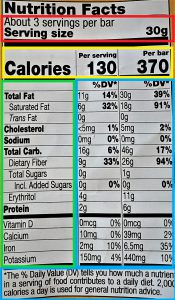Reading time: Approximately 5 minutes
Do you know how to interpret food labels?
Imagine you are grocery shopping and whether you stop by at the yogurt section, or the oatmeal section, there are so many options there, which ones to choose based on the nutrition facts? Nutrition facts are not difficult to understand, and are composed of four main sections. Check the chocolate bar food label below. I highlighted each section with a different color for a better understanding.

1. Serving information (In red):
In that section you will find the serving information both per package (in this case per bar) and the serving size, (in this case 30g of that bar). The serving size refers to the portion an individual will usually eat or drink. The serving size is not a recommendation of how much you should eat, it only represents the expected portion people eat of a certain food.
2. Number of calories (In yellow):
This chocolate’s serving size is 30g and it has 130 calories. If you eat the whole bar, you will be ingesting 370 calories. Important note: In most labels, calories and nutrients are described by serving size only, not by the amount in the entire package. This label is a variation of most labels, this is a dual-column label, because it informs you of the nutrition facts per serving size and per package “per unit”.
3. Nutrient Section (in green):
Here you find the list of the main nutrients that can affect our health in both a positive, or negative way (e.g. cholesterol, saturated fat). The nutrient facts list might include information on the amount of fats, cholesterol, sodium, carbohydrates, fiber, added sugars, protein, vitamins and minerals. Thus, when grocery shopping opt for foods with lower amounts of added sugars, cholesterol, saturated fat and sodium.
4. Daily Value Percentage (% DV) and Footnote (in blue):
As noted in the chocolate bar’s footnote “The % Daily Value (%DV) tells you how much a nutrient in a serving of food contributes to a daily diet. 2.000 calories a day is used for general nutrition advice.” This simply means that the nutrient section is calculated based on a 2,000-calorie diet. For instance, 30g (serving size) of this chocolate bar has 6 grams of saturated fats, which represent 32% of the daily recommend intake of saturated fat for a 2,000-calorie diet.
Usually a (%DV):
(Less than 5 % = low)
(Higher than 20% = high)
Time to Test your knowledge:
![]() Right in the comments below what do you think are the answers for these questions:
Right in the comments below what do you think are the answers for these questions:
- How much saturated fat is in the whole chocolate bar?
- TRUE OR FALSE: If an individual eats the whole chocolate bar throughout the day, s/he will be already ingesting 91% of the daily recommended amount of saturated fat for that day.
- One serving of this bar which is 30 grams, provides a low or high amount of fiber according to the daily value percentage (%DV)?
![]() Food labels are important tools to help you make informed healthier choices.
Food labels are important tools to help you make informed healthier choices.
Source: UF/IFAS Pest Alert



